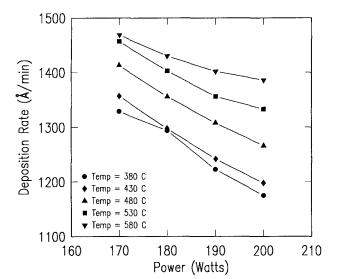The qualities of plasma-enhanced chemical vapor deposited (PECVD) silicon nitride films can be improved by increasing the deposition temperature. This report compares PECVD silicon nitride films to low pressure chemical vapor deposited (LPCVD) films. The dependence of the film properties on process parameters, specifically power and temperature, are investigated. The stress is shown to shift from tensile to compressive with increasing temperature and power. The deposition rate, uniformity, wet etch rate, index of refraction, composition, stress, hydrogen content, and conformality are considered to evaluate the film properties. Temperature affects the hydrogen content in the films by causing decreased incorporation of N-H containing species whereas the dependence on power is due to changes in the gas-phase precursors. All PECVD film properties, with the exception of cenformality, are comparable to those of LPCVD films.
This report compares high quality PECVD silicon nitride films to LPCVD films. The quality of the PECVD films was achieved through process optimization and increased deposition temperature. The dependence of material properties on process parameters, specifically power and temperature, were investigated. Preliminary experimentation showed that these process variables have a significant effect on film quality with minimum effect on deposition characteristics (deposition rate, uniformity, and foreign material). Film properties that were evaluated include deposition rate, uniformity, wet etch rate, index of refraction, composition, stress, hydrogen content, and eonformality, The dependence of these properties on deposition conditions are discussed. Finally, the use of PECVD films in place of LPCVD films is considered.
PECVD silicon nitride has been deposited and characterized in several reactors. 1-6 However, material properties cannot be correlated to process conditions independent of reactor configuration. Films deposited under different conditions display different chemical structure. This difference in structure can lead to variations in trends of material properties with deposition condition. The similarities and differences in material characteristics are noted where possible.
Deposition rate and nonuniformity vs. temperature and power are shown in Fig. 1 and 2, respectively. The uniformity was optimized prier to this experiment. The variables investigated here have a negligible effect on the film uniformity. The deposition rate decreases with increasing power as expected from increased ion bombardment. Howevel, the generation of reactive precursors can increase with power as well, tending to increase the deposition rate. The activation energy extracted from Fig. 1 was approximately 1 kcal/mol. This amount indicates that the deposition is limited by a transport process, either at the surface or in the gas phase. Figure 3 shows the dependence of conformality on power and temperature. Conformality is defined as the ratio of the film thickness on the sidewall to that on the top horizontal surface. Although there is little dependence on power, the conformality increases with temperature. The relatively high values of conformality for these films indicate the deposited species have a high surface mobility or a low sticking coefficient. The increase of conformality with temperature, but not power, indicates that either (or both) mechanism may be responsible. The slight decrease in conformality with increasing power is consistent with a mechanism of an increasing sticking coefficient with power as suggested by Smith.

Fig1
Figure 4 shows the dependence of the index of refraction on power and temperature. The index of refraction increases with increasing temperature and decreases with increasing power. For reference, the index of refraction for the LPCVD material is 1.98 and 2.01 for deposition at 720 and 780 respectively. The change in the index is correlated to a change in stoichiometry. Stoichiometry, determined by RBS, vs. index of refraction is shown in Fig. 5. To explain the dependence of stoichiometry on temperature and power, both the gas phase and surface chemistry must be considered. Figure 6 shows the dependence of wet etch rate on temperature and power. Although there is little dependence of the wet etch rate on power, there is significant dependence on temperature. Decreased hydrogen content affects the wet etch rate to a greater degree than compositional changes. Therefore the major effect of increased temperature is to reduce the hydrogen content in the film. Total bonded hydrogen vs. wet etch rate has been plotted in Fig. 7. It can be seen that the wet etch rate is approximately linear with hydrogen content to roughly 10% (including LPCVD films), above which it increases rapidly. The composition change with power is caused by increased dissociation of ammonia with power providing more nitrogen precursors. This agrees with a mechanism of deposition from aminosilane precursors, 3 SiH4(NH2),, primarily triaminosilane.
The stress in the PECVD films is dependent both on power and temperature. Increased deposition temperature tends to produce more compressively stressed films due to increased thermal stress. The thermal stress increases by approximately 108 dyne/cm 2 for every 50℃ increase of the deposition temperature above the measurement temperature. TM Although the stress is indeed becoming more compressive, there appears to be both a thermal and an intrinsic component to the change. Increased power tends to make the stress more compressive also. Ion bombardment causes the intrinsic stress to become more compressive I.5by breaking bonds and creating damage by ion implantation.
The dependence of N-H, St-H, and total bonded hydrogen, on stress are plotted in Fig. I0 and 11. In Fig. 10, Si-H and N-H are shown as open and solid symbols, respectively. There is no correlation between the Si-H bonds and the stress. However, there is some correlation with the N-H bonding. Figure 11 shows the weak dependence of stress on total hydrogen; as bonded hydrogen decreases, tensile stress first decreases and then shifts to compressive stress.
上一篇: 薄硅衬板上半导体芯片热力学性能研究